Text
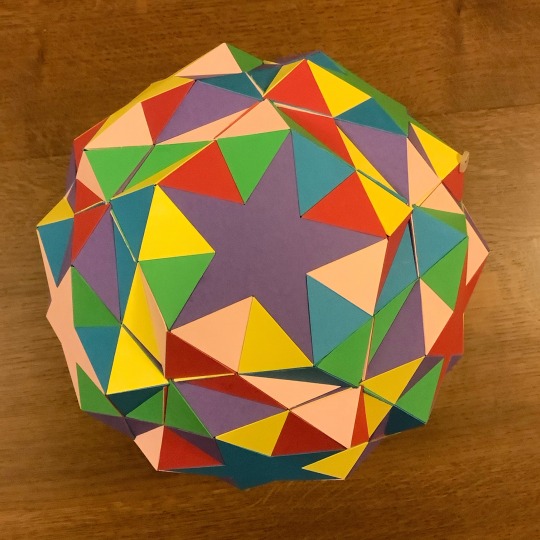
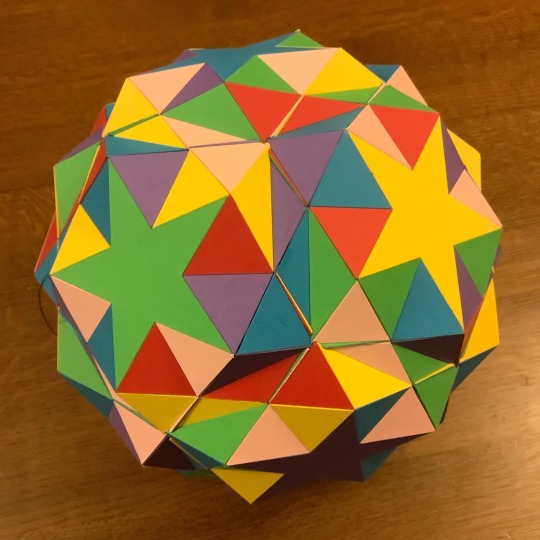
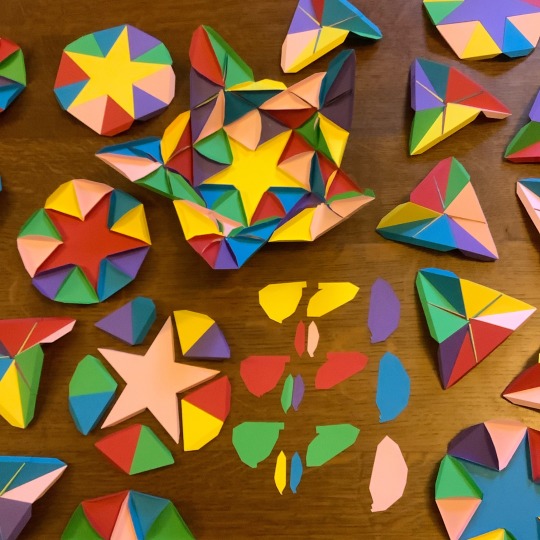
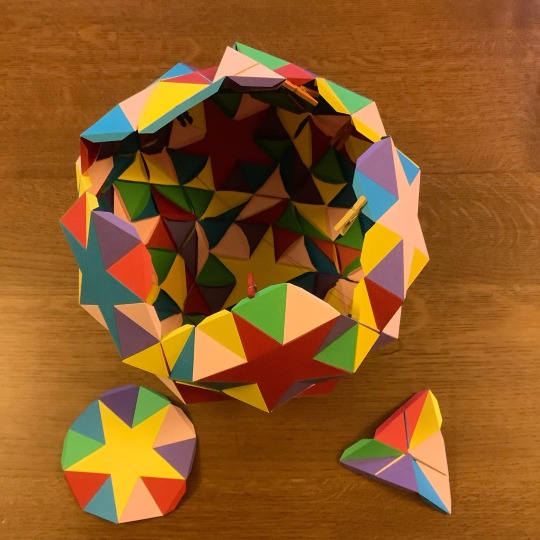

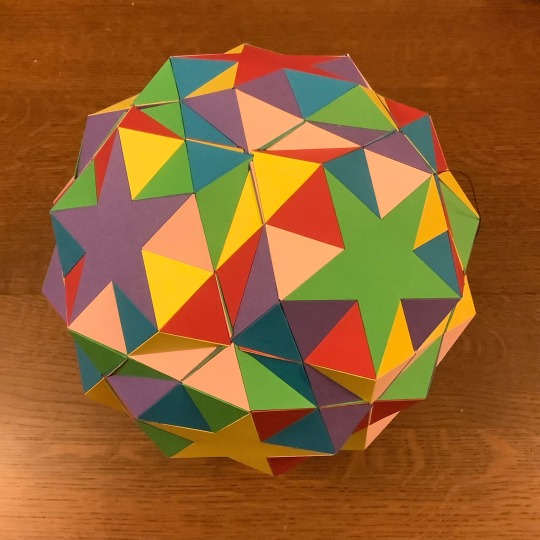
This is a Snub Dodecadodecahedron, made from 12 pentagrams, 12 pentagons and 60 triangles. I made it in six colours, with the pentagon/pentagram faces in parallel planes having the same colour. I managed to colour the triangle faces so that adjacent facets never have the same colour. As usual, I made a detailed colour-plan before I started assembly.
The most remarkable feature of the shape is that it has facets that are very thin slivers. Many representations you might see online are not accurate enough for you to make them out, so I included a close-up to illustrate how intricate they are.
Not surprisingly, this was extremely difficult and time consuming to make. The result is not the standard I was aiming for, but I still like the finished piece. The overall effect is slightly unsettling, as if the polyhedron is fractured, and not quite the right size for itself.
59 notes
·
View notes
Text
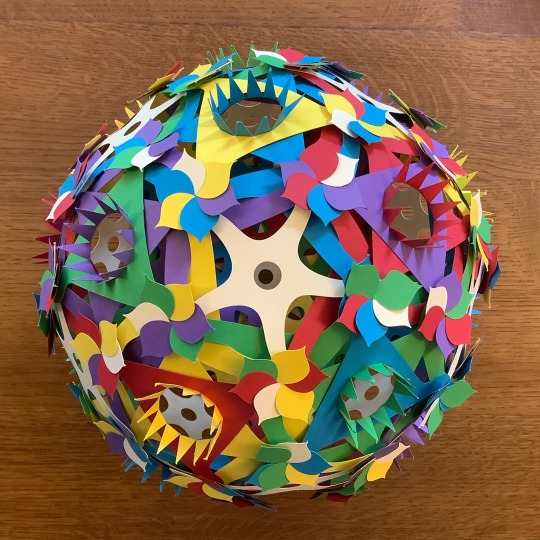
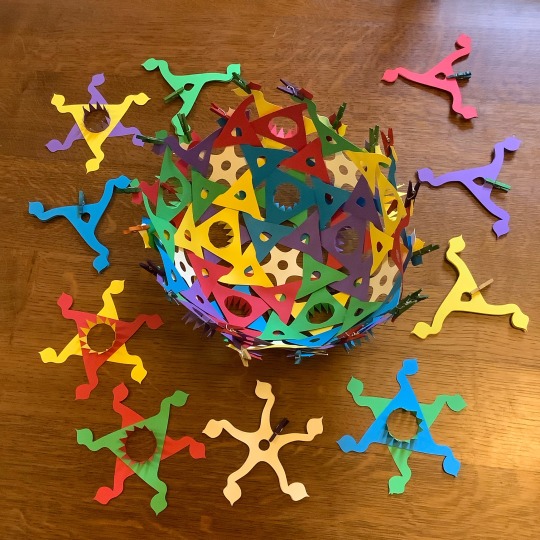
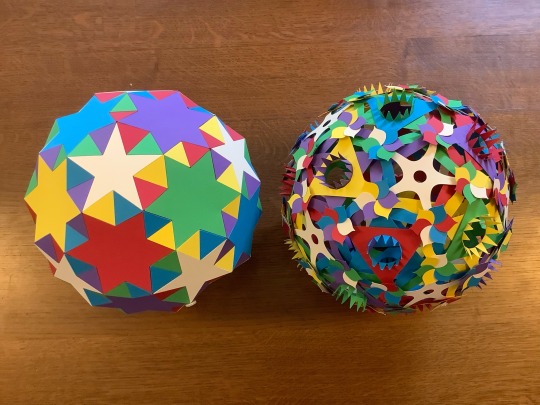
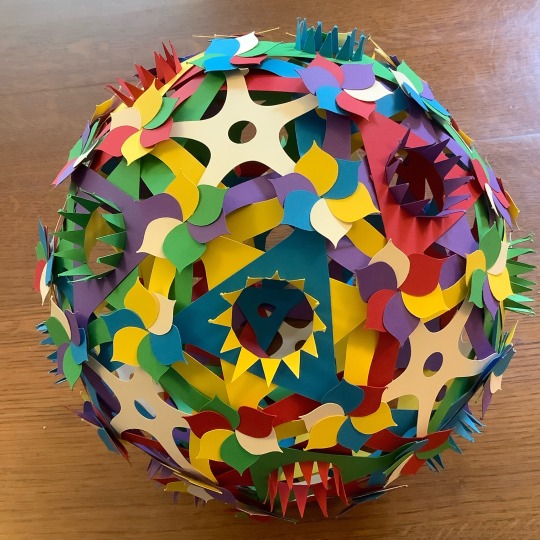

This chaotic looking object is something I designed, based on the small snub icosicosidodecahedron that I made recently. Like it’s counterpart, it has twelve pentagram-type pieces and one hundred triangle-type pieces. I used cutaway faces with petal-shaped hooks at the corners. They were designed so as to veer around each other and form a rosette at each vertex, so no glueing was necessary.
In the “normal” version, there are twenty skew hexagram faces formed from pairs of triangles. In this version I was able to use a separate piece for each triangle in the hexagram, so they could have separate colours. It turns out that each of the twenty possible pairs of different colours is represented in the finished model. I decided to fold a crown-shape on the lower piece through a hole in the upper piece, which helped to secure the pieces together as well as look cool.
Assembly took much less time than for the normal version, but the design phase was more difficult. I had to do some maths to determine the angles of the petal-hooks, so that they ended up evenly spaced around the vertices in the finished model. The sixty snub pieces are not symmetric, but are difficult to orient by eye, so I put a teardrop-shaped hole in them so I wouldn’t get confused.
As usual with this style of model, the interior is very attractive too. Fortunately it is still visible through the numerous holes.
35 notes
·
View notes
Text
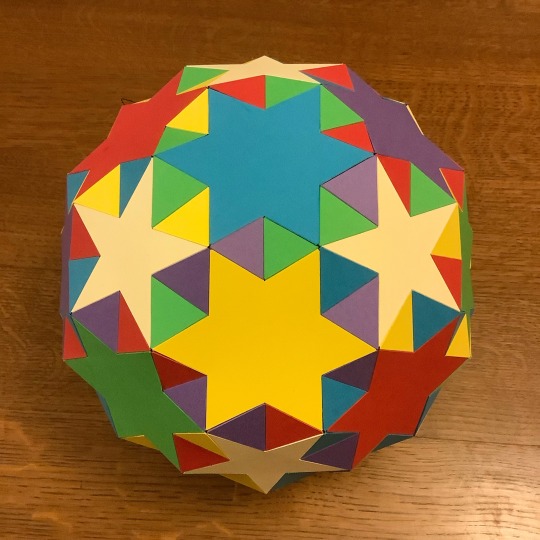
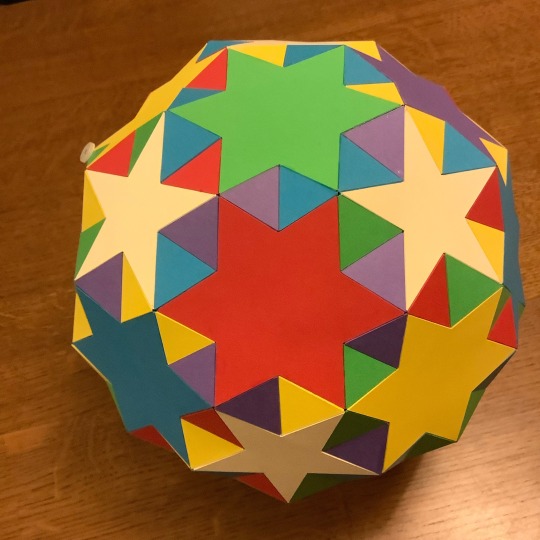
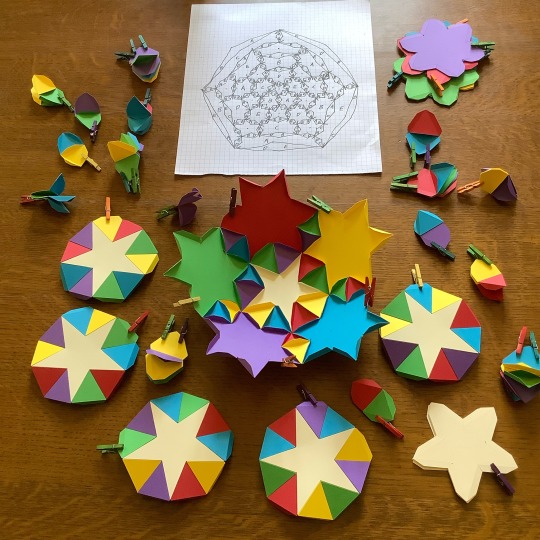
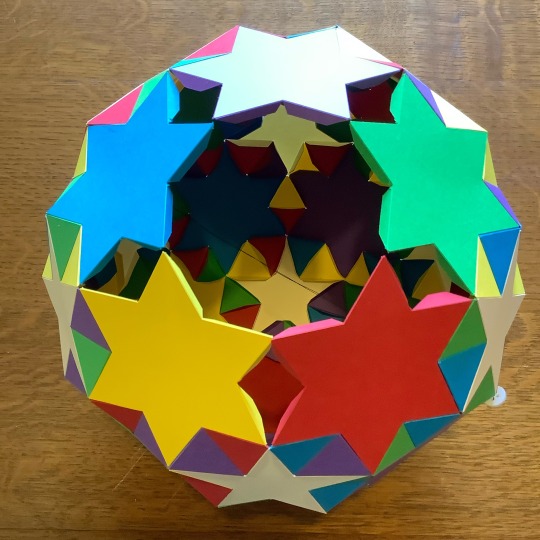

This is a small snub icosicosidodecahedron, with twelve pentagram faces and 100 triangles. There are twenty pairs of triangles that overlay each other at skew angles to form irregular hexagrams in the planes of an icosahedron. The remaining sixty triangles are the snub faces, and they don’t share any symmetries with the polyhedron they are part of. Although this shape is non-convex, it is very close to spherical, and the angles between adjacent faces are extremely shallow.
Unusually for a snub polyhedron, this shape has mirror symmetries.
I chose, an icosahedral colouring pattern using five colours plus a sixth colour for the star faces. It turns out that I could select colours for the snub faces so that they followed the map colouring principle (adjacent regions have different colours). Because the different kinds of facets are so similar, I gave them distinctive tabs to avoid mistakes during assembly. Preparing a detailed colouring plan in advance was also essential, but after that construction was straightforward. I was very pleased with the result.
30 notes
·
View notes
Text
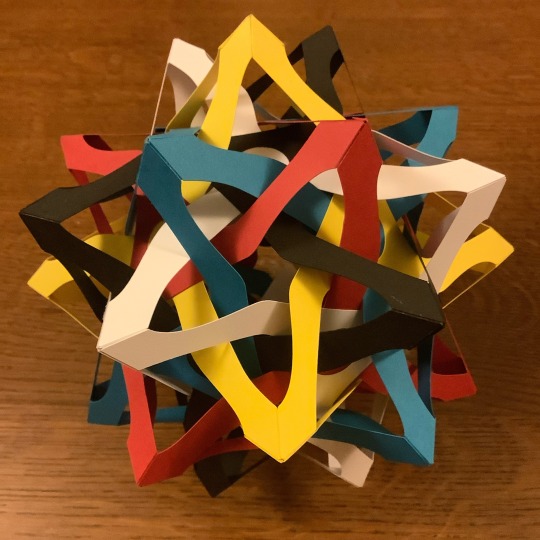
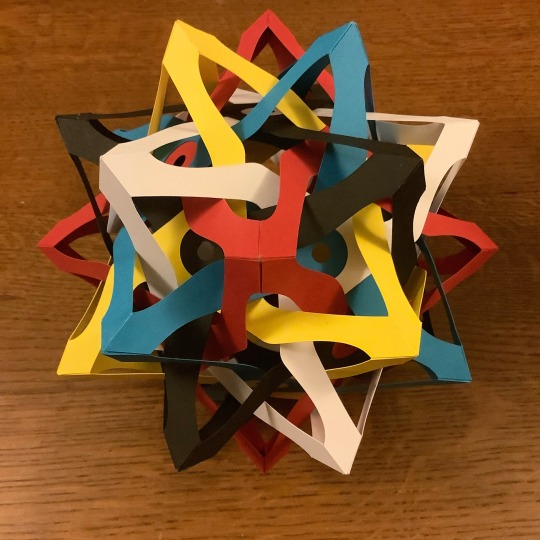


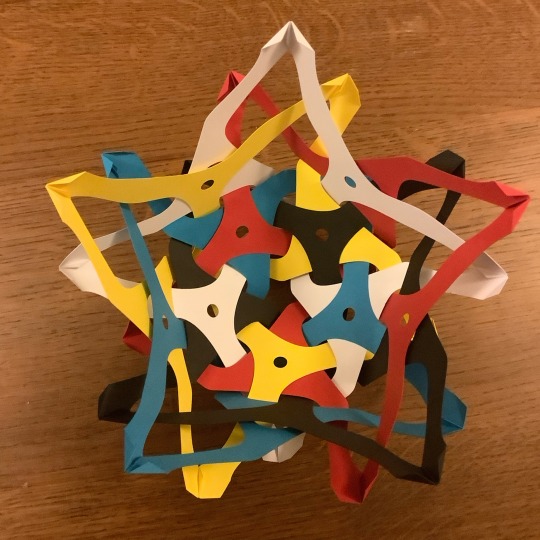
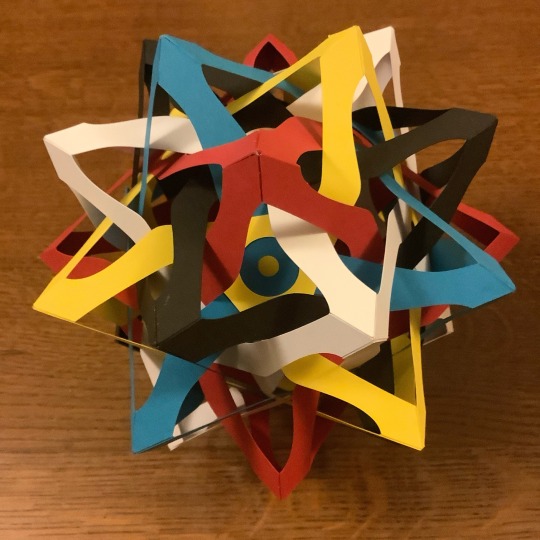
Compound of five octahedra.
The third stellation of the icosahedron is essentially the same as a compound of five octahedra. However, most models don’t address the issue that there are 5x8=40 octahedron faces in the compound and only 20 faces in the stellation. This is explained by noting that the triangular octahedron faces come together in pairs, but of course that means that the colour of each stellation face is ambiguous. A solid model can avoid the issue because the visible outer corners are distinct and can have separate colours. With this model, I have used cutaway faces, so the pairs of faces must overlap each other.
By using two different cutting patterns, alternating over each octahedron, the model can be assembled without the pieces interfering with each other. I used differently sized central holes so that the pairs of colours can be seen easily. It turns out that every ordered-pair of colours is represented in the completed model.
As usual, the interior view is very attractive, but it is sadly not visible in the finished piece. I like the overall effect - it reminds me of Celtic knot-work.
17 notes
·
View notes
Text
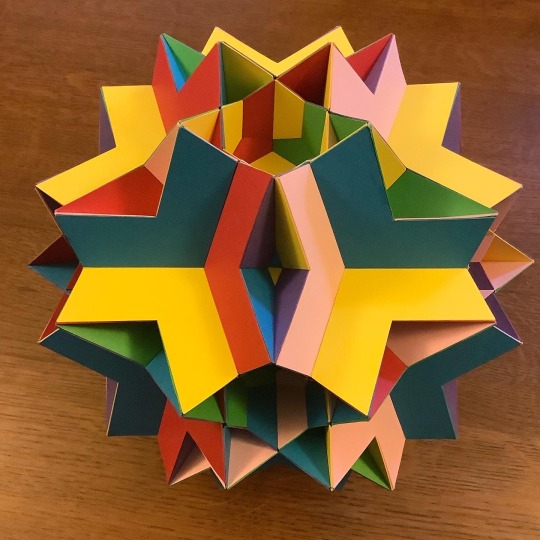

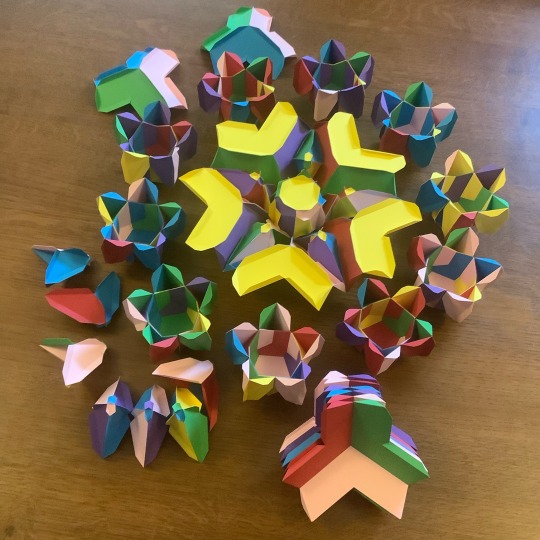
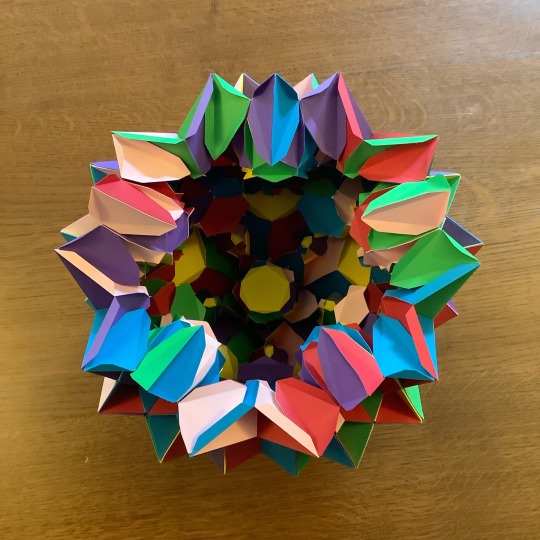

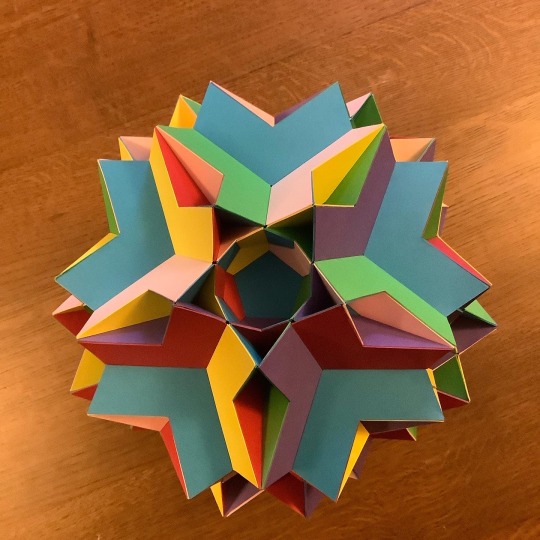
This shape is a Great Rhombidodecahedron. It has twelve decagram faces and thirty squares with intersections that are difficult to get your head around. The facets vary a lot in size ranging from the large chevrons to the tiny triangles in pairs at the base of the diamond cups.
There are many deep concavities, including twelve cups with parallel edges going up the sides. It turns out that each decagram face is perpendicular to ten of the squares (though not the squares' edges). This suggested a colouring scheme - I grouped the squares and decagrams into six different coloured sets of two decagrams and five squares. The squares in each set are perpendicular to the decagrams. By doing this I ensured that very few facets are adjacent to other facets of the same colour. To get everything right I had to prepare a detailed colouring plan before I started gluing.
As usual for a polyhedron this complex, it was fiddly, time consuming, but also very rewarding to make. With the completion of this shape, I have now made each of the 75 uniform polyhedra at least once, apart from the non-convex snub polyhedra. That leaves me ten more, including some real monsters! I guess it will take me a long time before I finish the set.
33 notes
·
View notes
Text
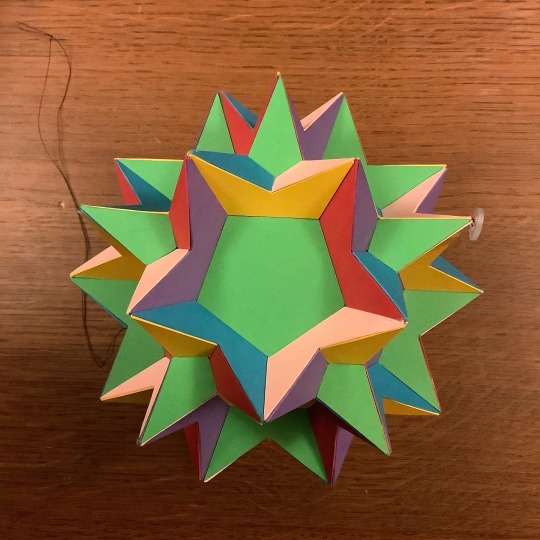



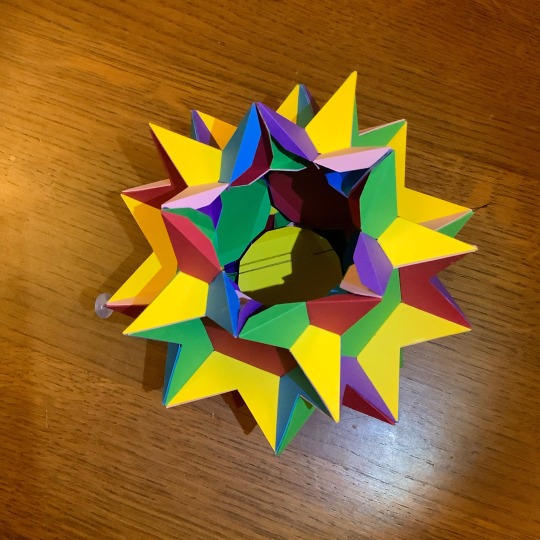

This shape is a great dodecahemidodecahedron. It has twelve pentagrams and six decagrams in six sets of parallel planes; each plane has its own colour. It is closely related to the great icosahemidodecahedron that I posted recently, having the same vertices and edges, and decagrams that go through the centre of the shape.
I constructed it in much the same way as the other shape, making the concave sections and then assembling them. It was also quite fiddly because they were tightly packed on the inside.
I like how the colours look completely different at different orientations.
50 notes
·
View notes
Text
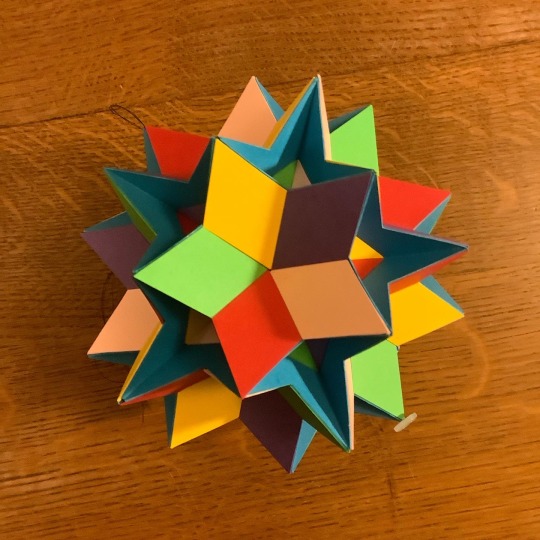
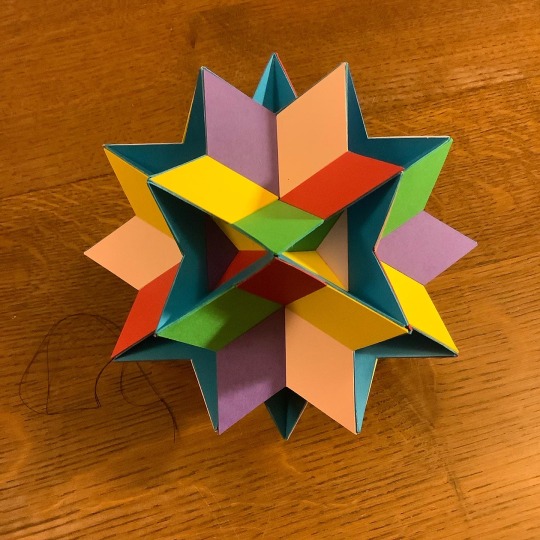



This is a Great Icosahemidodecahedron. It has twenty triangles in five colours and six blue decagrams. The planes of the decagrams all pass through the centre of the solid.
I made it by first gluing the 12 rosettes of diamonds and the 20 blue cups with coloured facets at their base. Then I assembled the components together. On the inside they fit very tightly with barely enough room for the tabs. This made an otherwise straightforward construction a bit fiddly.
I think the result looks a bit like a ball of flowers.
23 notes
·
View notes
Text
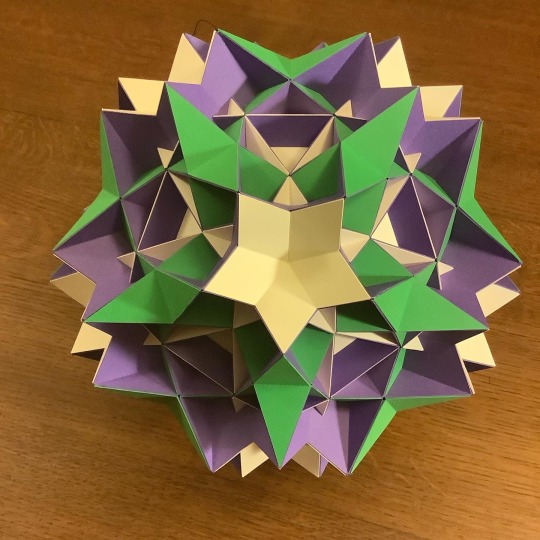
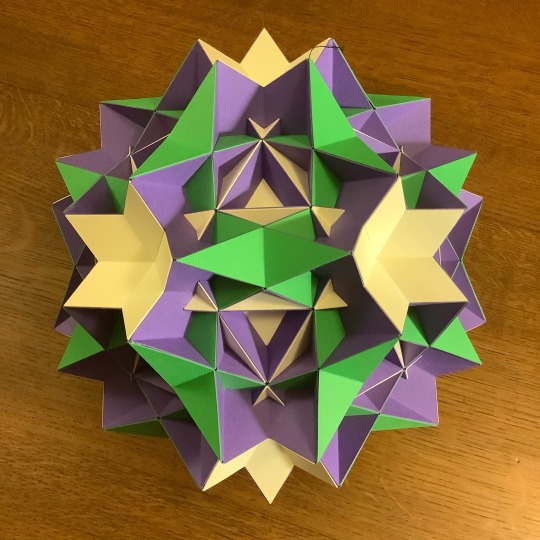
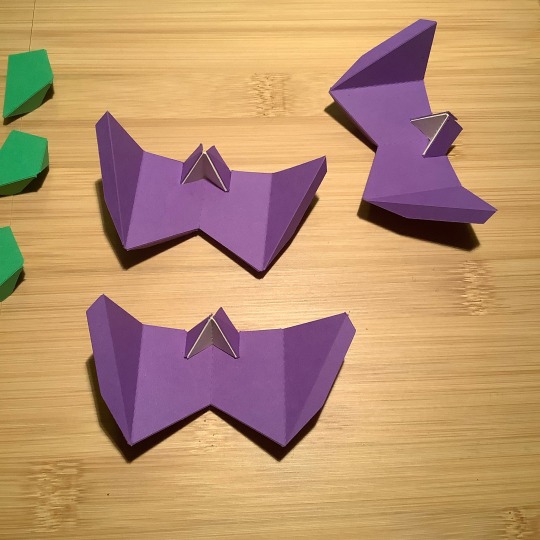
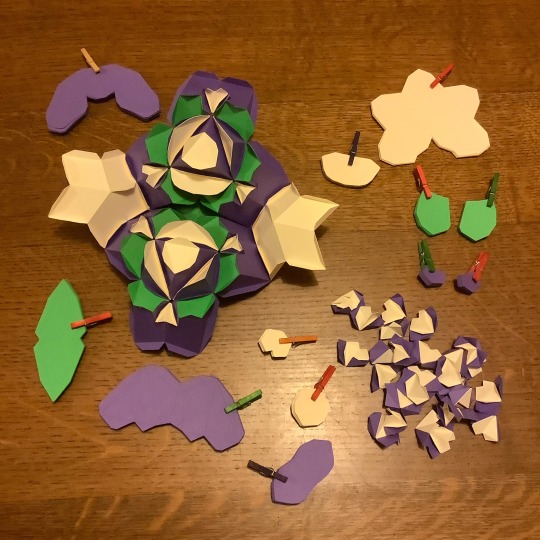
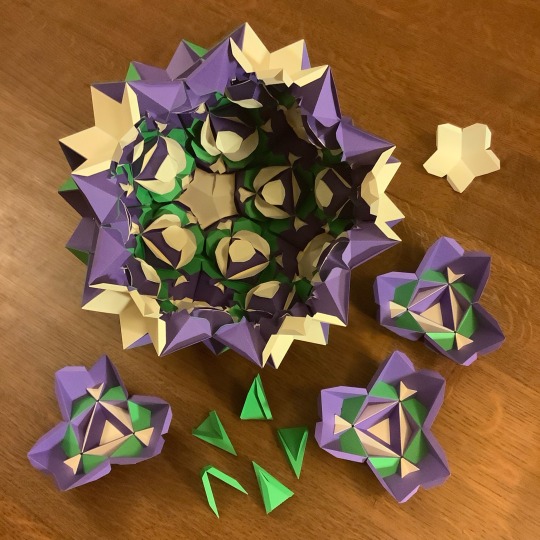

This is a Quasirhombicosidodecahedron, with twelve green pentagrams, twenty cream triangles and thirty purple squares.
It is quite intricate, with nine edges crisscrossing around each of the triangular cups. Wenninger described it as “not too difficult to make” but “requiring much perseverance“. I guess I would agree, but the sheer amount of work means it is not for the faint hearted!
The finished model looks very impressive, with visual impact from the star faces or the triangular faces depending on the orientation. I also liked how the purple sections looked like bats before I glued them in.
65 notes
·
View notes
Text
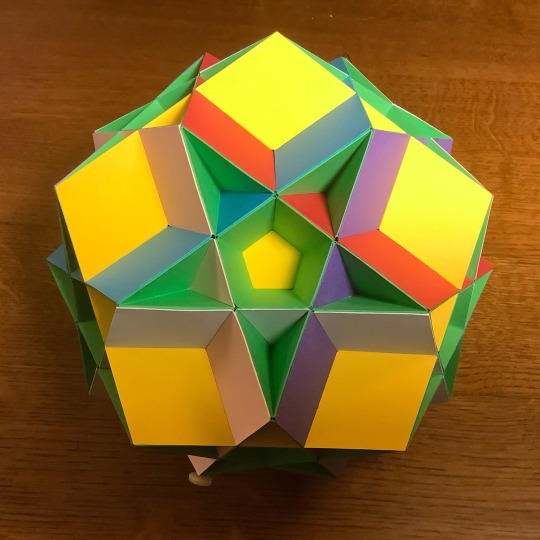
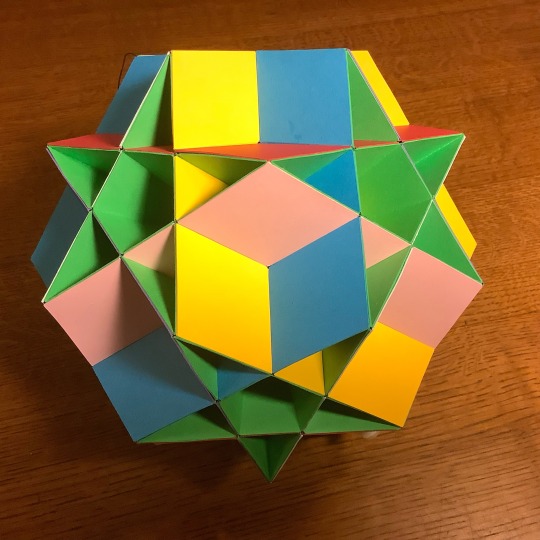
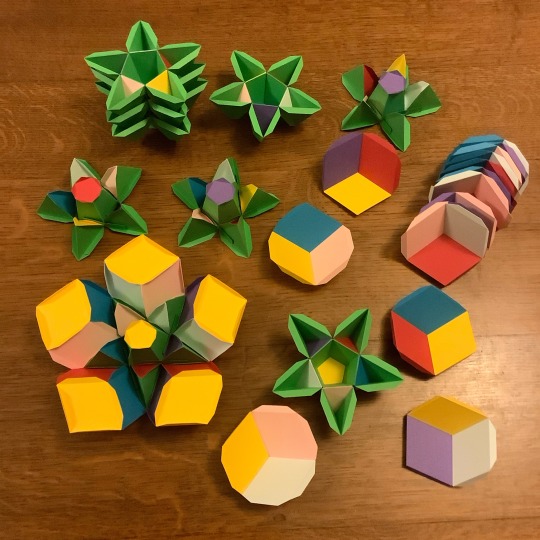
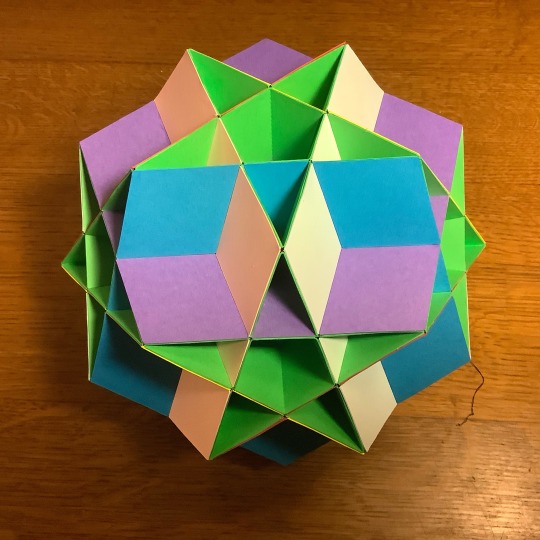
This is a great dodecahemicosahedron. It has twelve pentagons in six colours, and ten hexagons in green. The hexagons all go through the centre of the shape.
I made it by assembling twenty corner sections and twelve star-shaped sections, then glueing these together. It was quite straightforward to make, and very satisfying. I like the deep pentagonal cups with the coloured facets at the base.
40 notes
·
View notes
Text
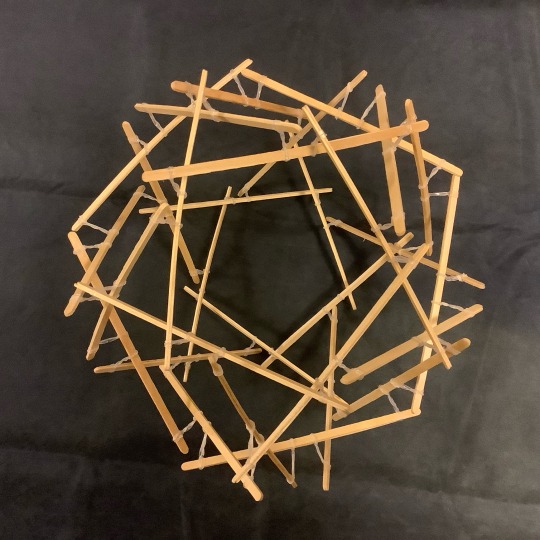
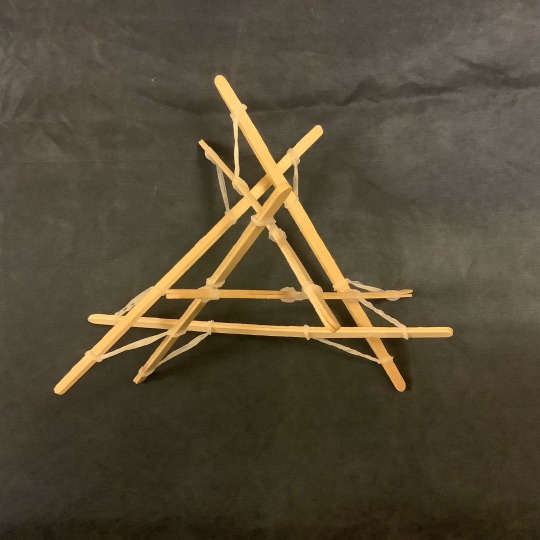
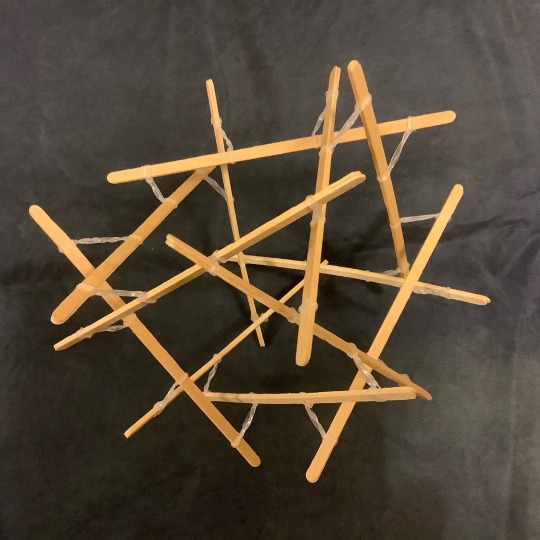
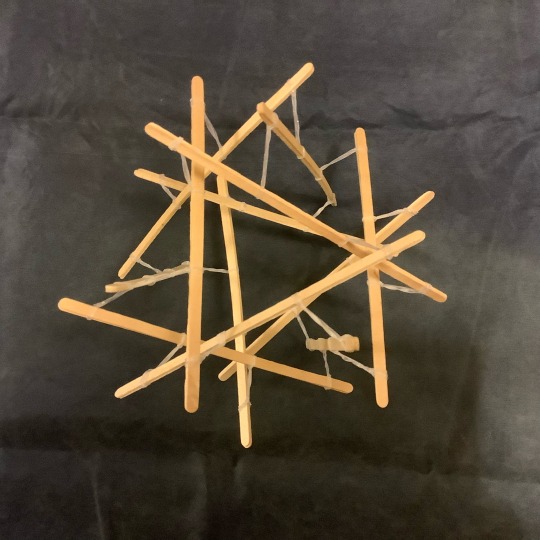

These models have rigid struts that are connected to each other using only tension. None of the struts touches any of the others as the elastic pulls them apart. They are sometimes called tensegrity structures but they don’t meet the strict definition. This is because the struts are not only connected at their ends and so they are not in pure compression.
The five models are my own design, based on the five Platonic solids. They are made from coffee stirrers and small elastic bands used in hairdressing. They are considerably quicker and easier to make than my card models.
Each model is highly symmetrical though the sticks are at skew angles to each other. The elastic in them makes them nice to handle, and they bounce if you drop them on the floor (something I would never dare to do with my card models).
54 notes
·
View notes
Text




This shape is a Great Dodecicosahedron. It has twelve cream coloured decagrams and twenty hexagons in five different colours. The hexagons are difficult to make out because some facets are in highly concave sections and different parts of them are visible from different sides.
To make it I prepared all the concave sections and then glued them to the stars. Each such section had a different arrangement of colours from all the others, so I made a colouring plan before I started glueing. It was time consuming but very satisfying to make.
67 notes
·
View notes
Text
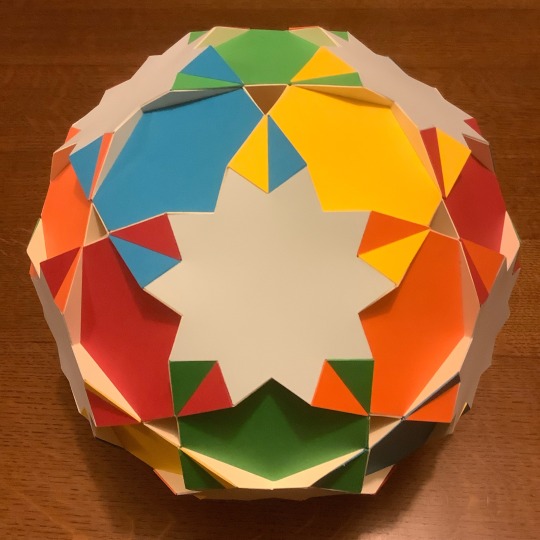

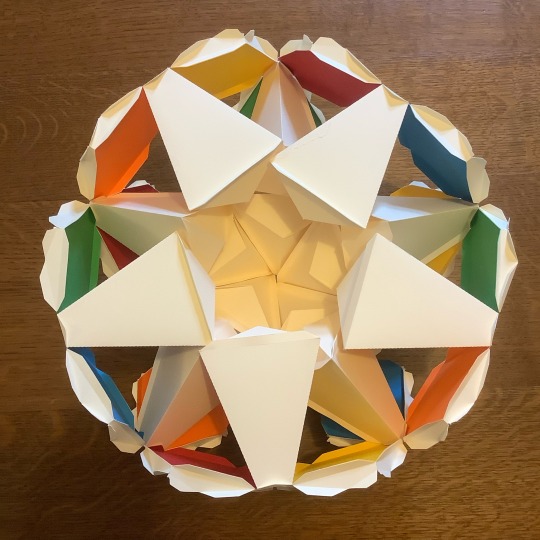



This polyhedron is called the truncated dodecadodecahedron. It has 12 decagrams (pale blue), 12 decagons (cream), and 30 squares (in five colours). What is remarkable about this shape is that it has twenty large cavities formed by the decagonal faces. The openings are small triangular holes that are easily missed. The "in-progress" pics allow you to see them clearly.
Glueing this shape together was quite difficult. Once I had made the twenty cavities I joined them all together using the large facets of the squares. This was the hardest part because bulky pieces were being glued with only short tabs around the triangular holes. I used masking tape to hold things in place temporarily. Thankfully this did not damage or mark the card. At this point the cavities all together had the shape of the great stellated dodecahedron (with its points snipped off).
There is a similar shape with octahedral symmetry (included in the pictures above) with eight cavities in the shape of a stellar octangular (also with its points snipped off). In each case, given that most people never notice, I wondered if it was worth the trouble to include the cavities at all! I guess it would have bothered me more to know that I had cheated.
62 notes
·
View notes
Text
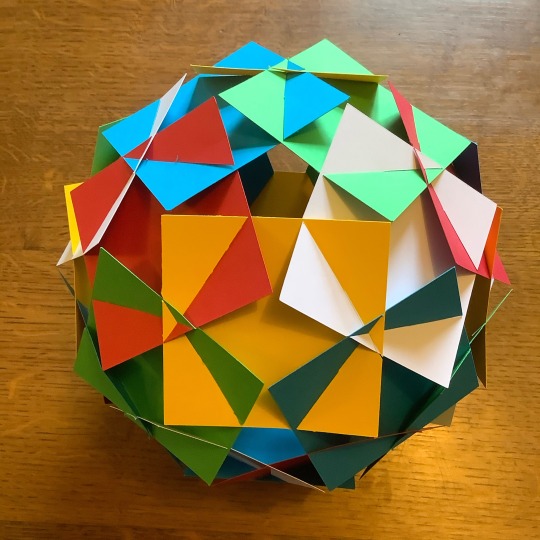
This shape is made from 30 squares slotted together with no glueing. The squares are arranged in the planes of a rhombic triacontahedron. I designed it from scratch but there are plenty of templates available on the Internet as well.
Compared with my usual shapes this took a very short time to make - just a few hours from beginning to end, compared with days or weeks.
The arrangement of squares is exactly the same as in the rhombicosahedron and the rhombidodecadodecahedron that I have made previously.
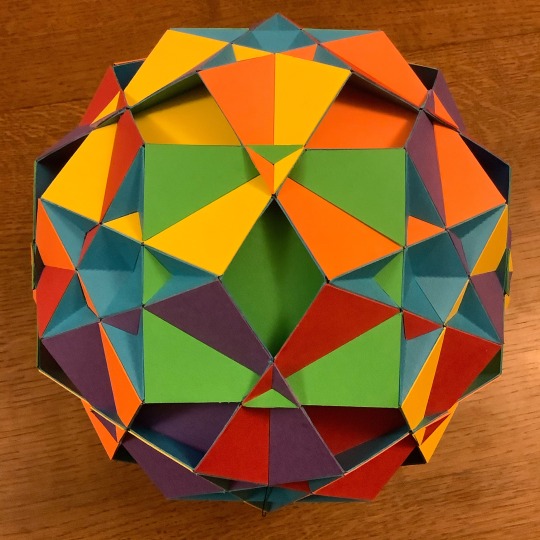

155 notes
·
View notes
Text

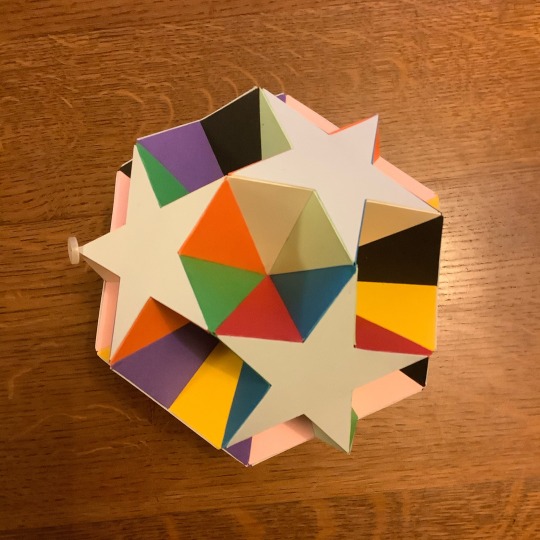


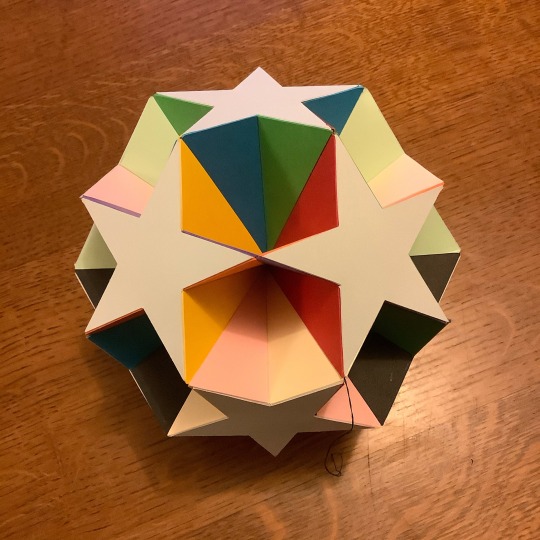
This is a small dodecahemicosahedron. It has twelve pentagrams and ten hexagons. as implied by the “hemi” in the name, each of the hexagons goes through the very centre of the shape. I used a different colour for each one.
If a model has complex colour arrangements, I sometimes draw out a colouring plan to help me select the right pieces while glueing. This enabled me to make all the twenty conical components in advance before final assembly. You can see that it gets very crowded near the centre - I had to trim the tabs to make sure that everything fitted together well.
56 notes
·
View notes
Text
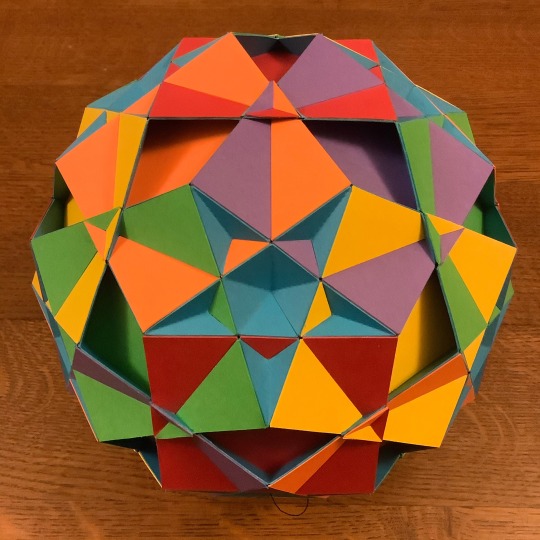


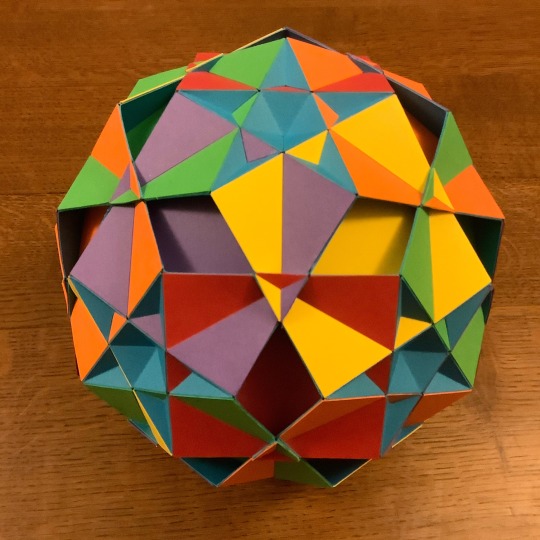
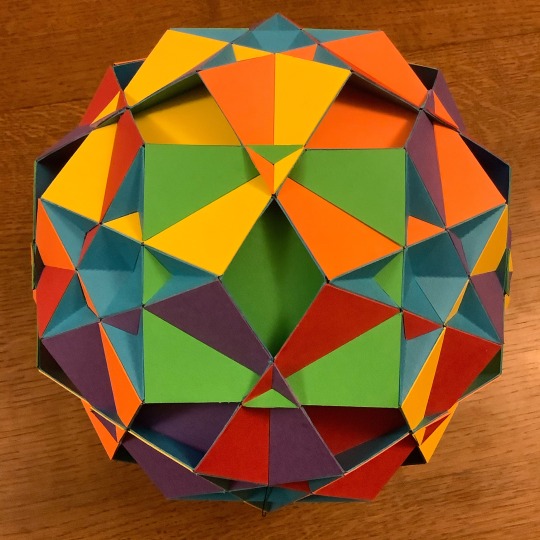
This is a rhombicosahedron, comprising twenty hexagons in blue and thirty squares in five different colours. Very little is visible of the hexagon faces, since there are so many sharp overhangs.
This was a real challenge because different joints are so closely crowded in small spaces. I had to abandon the usual double-tab technique for many joints just to make enough room for the pieces to fit together.
This was very satisfying to make even though it was so fiddly. The result is a bit messy in places but still very nice to look at. The diamond shaped cavities remind me of jewel settings for some reason.
76 notes
·
View notes
Text
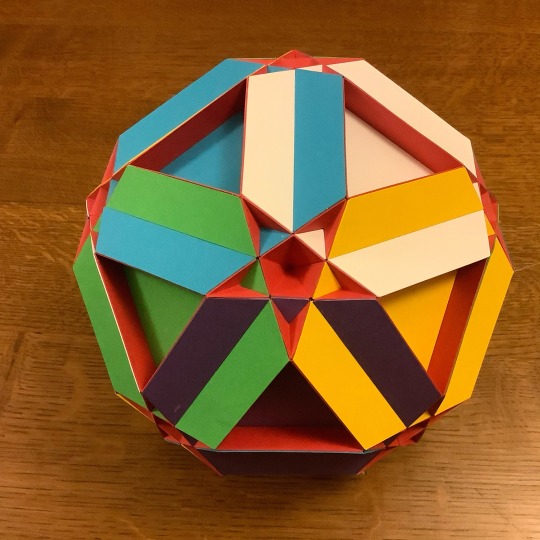

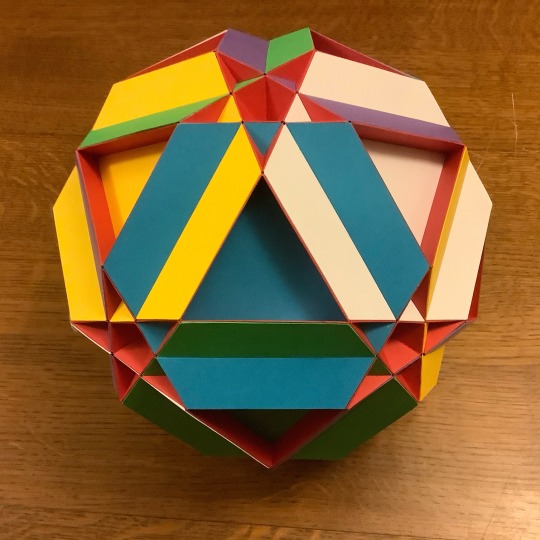
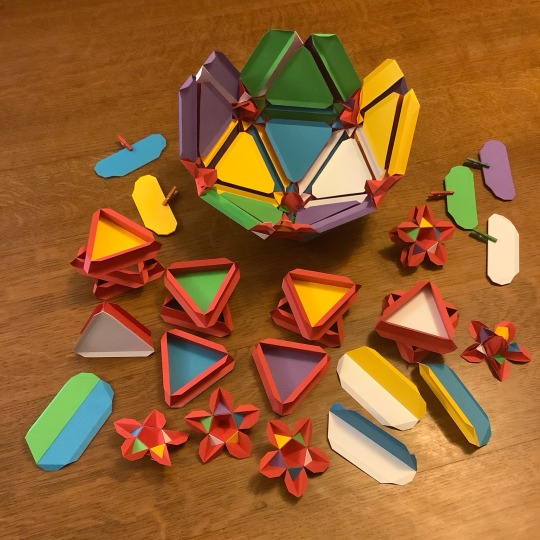
This shape is a small dodecicosahedron. It has twelve decagons in red, and twenty hexagons in five different colours. It was not documented until 1954 when HM Coxeter published his paper “Uniform Polyhedra”.
A knowledge of group theory can help when making shapes like this. It turns out that the colour arrangements around the twelve stars are based on the even permutations of four colours. This allowed me to quickly write down the valid colour arrangements, and then construct the star shaped sections in advance. This is more efficient and less error prone than trying to deduce the colours on the fly during assembly.
As usual, it was fun but time consuming to make.
93 notes
·
View notes
Note
Thanks for your work, where did you get the coloured card from? I used old computer cards to build my models, and then painted them before assembly, obviously your method is superior. Like you I use Wenninger's Polyhedron Models as my source.
Thanks for your interest. I get A4 160gsm card from online stationery suppliers. Quality can vary so I had to try different companies to find card I was happy with. These days I use a computer controlled blade to cut the shapes, but before that I got great results with just ruler, compasses and a craft knife. Wenninger’s book is definitely the best single source, but I have a bunch of other useful books too, as well as the Great Stella software. Good luck with your model-making!
7 notes
·
View notes